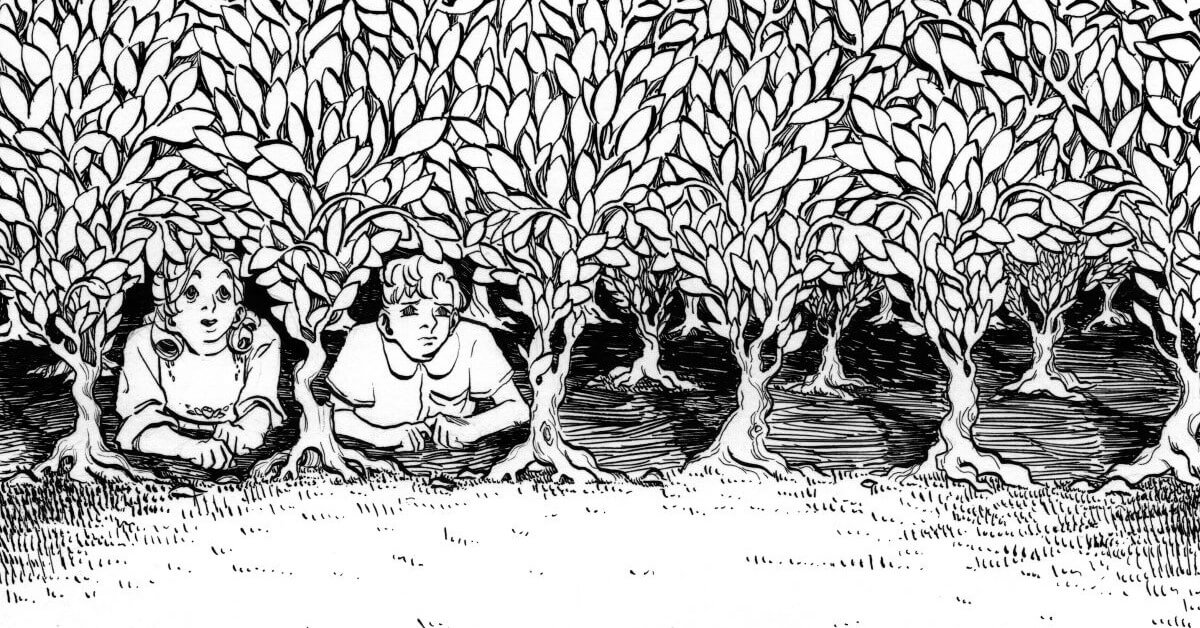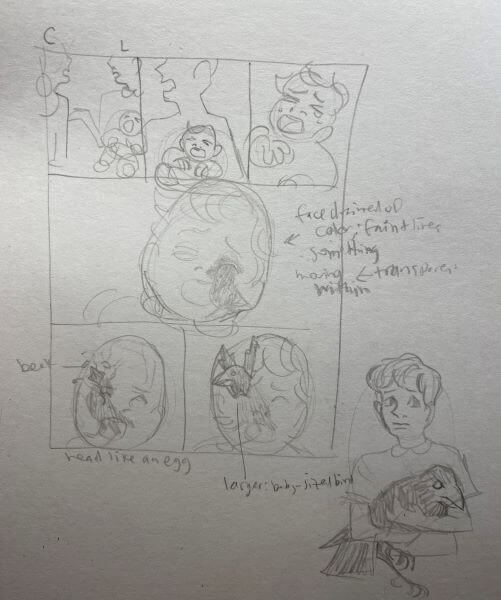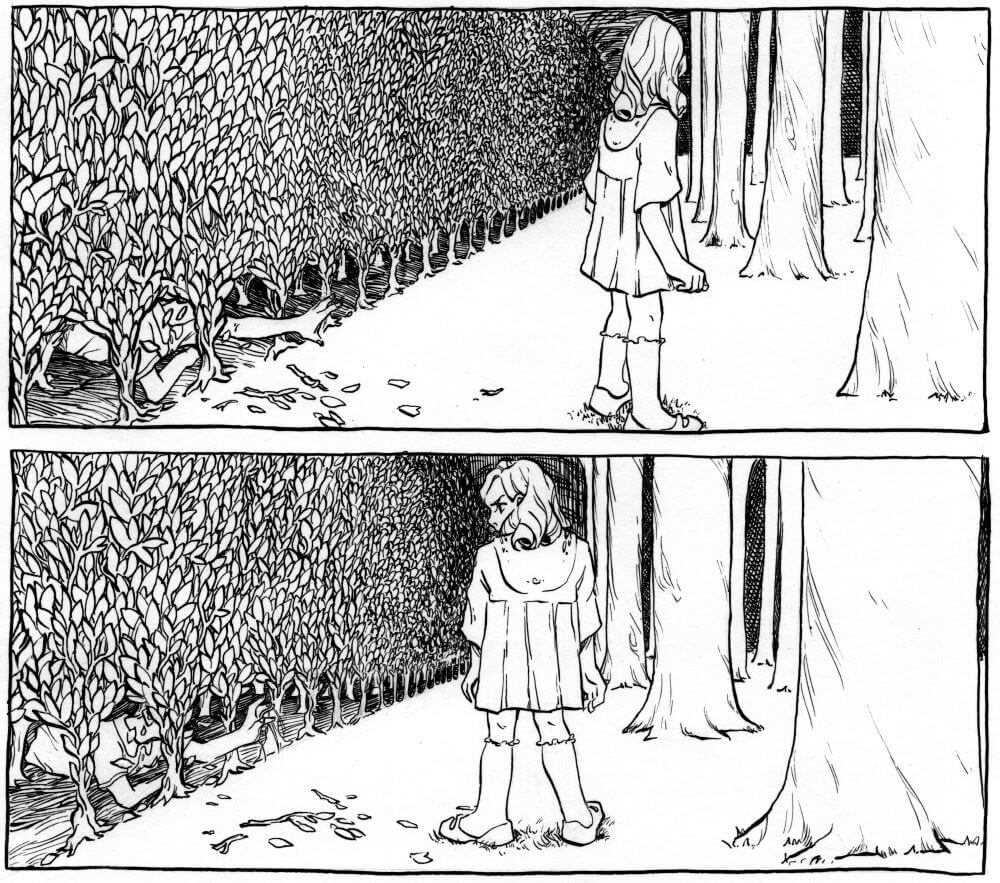
Art as Obedience

This past summer, I had the good fortune of spending a month with my grandparents, Nana and Skeeter, at their home on Mobile Bay in Alabama. I came to them planning to draw the first chapter of my Duffy Fellowship project: a graphic novel tentatively entitled Carol in Eden, and I believed that this isolated, spiritual oasis would be the most efficient place to get the work done. Ironically, in this quiet setting, distractions only grew louder, tending to take the form of poetry.
As it turns out, poetry (done right) is disruptive, and T. S. Eliot’s poem “Journey of the Magi” was one that derailed my artistic process to no end that month. The work is quite humorous and mostly gives voice to the Magi’s many complaints, tacking on their witness of the Christ Child at the end, as if it were a mere afterthought. Yet, although they gave an underwhelming account of the Nativity, the Magi are increasingly impacted by what they’ve seen as they journey home. Here is the final stanza from Eliot’s poem:
All this was a long time ago, I remember,
And I would do it again, but set down
This set down
This: were we led all that way for
Birth or Death? There was a Birth, certainly,
We had evidence and no doubt. I had seen birth and death,
But had thought they were different; this Birth was
Hard and bitter agony for us, like Death, our death.
T. S. Eliot, “Journey of the Magi”
The first time I heard these words, I didn’t pay attention to them, since I was dicing a vidalia. Childishly, I cared more about keeping any large chunks of the onion from entering the salad and ruining a bite: poetry was a garnish for the ritual of dinner preparation, not the main attraction. Having arrived in Alabama only a few nights earlier, I was still new to my grandparents’ evening ritual of food preparation and poetry recitation. Not wanting to disappoint, I fixated upon cubing the tomatoes without squashing them and beating together the oil and vinegar in proper proportion. T. S. Eliot’s words, delivered in Skeeter’s southern drawl, floated in through my left ear and were promptly pushed out the right due to the lack of vacancy left by the thoughts of celery and avocado and dressing.
However, as everyone knows, great poetry has a life of its own, and the words simply fell into the romaine as I patted it dry with a too-damp tablecloth (I was still green at this point), and they crept between the folds between leaves. Later that night—after we’d taken our pre-meal stroll along the driveway and returned, washing our palms clean of the mosquito’s broken bodies—we sat down and picked up our forks. Together, we ate the poem-soaked meal, and the words (which, of course, were at this point hiding behind the far too large chunks of heart of palm I’d cut), wound up in our bellies. There, they were broken down by the acid lying in wait and then were sent out into our bloodstream.
That process takes some time, so it was well into the night when the fragments of Eliot’s poem began to stir in my veins. Specifically, it was the line: “But set down. This set down, This: were we led all that way for Birth or Death?” It bothered me. The strange, incoherent phrasing had ripped my attention from the vidalia, and now, as I attempted to draw the twenty-sixth page of Carol in Eden, the Magi’s question cemented itself in my imagination. Can one ever truly know one’s destination while they’re still on the road? That night, I fought the urge to abandon my drawing and reread the poem, reminding myself that the poem was not the priority. After all, if the evenings were for distractions (such as good food, great conversations, and quality time with family), then the night must be for work. I had a schedule, a quota to match, and leaving my duties to reread some poem was the last thing I was supposed to be doing.
To stay on track, I had to make sure the twenty-seventh page was penciled in before the night was up. It was the page which I most looked forward to drawing: a scene that served as the catalyst of the story’s action and conflict. On it, a baby, who harmed a fledgling crow, would be forced to take the place of the crow whose life he unintentionally took. This page would introduce the story’s central conflict (human nature as it relates to animal nature) and establish the strange and seemingly illogical justice represented in the Eden story. Carol would accept and take advantage of the consequences of her actions and intentionally break crows wings and frogs legs to give herself their broken features, all in order to reach and save her baby brother in the world of the crows, even if it hurt. The finale would be a face off between the broken, misshapen body of Carol and the costumed figure of Justice, who is buried beneath various bodies he’s been gifted: accepted out of lonely love.


(Image credit: Madison Morris)
I had spent three months conceptualizing this story from beginning to middle to end and a month writing the script and storyboards for this first chapter so that, when I came to Mobile, I brought with me what I thought was fifty pages of a bullet-proof opening chapter. However, sitting at that table with the Magi’s uncertainties and our family meal swirling in my veins, I discovered that I couldn’t draw the page as I had planned.
For a long while, I stared at the page but couldn’t make myself draw the baby turning into the bird. At last, I gave up and snuck into Skeeter’s office to reread “Journey of the Magi” but I couldn’t find it in the poetry anthology book from which Skeeter had read. So, I sat alone in my grandfather’s rocking chair, trying to remember the poem but ending up listening to the steady chirps of the cicadas, crickets, and frogs instead. My grandparents have a house with seams that sing, I noted. Eventually, I left the song and went to bed, expecting to wake up with an understanding of what was wrong with page twenty-seven and renewed willingness to draw.
But over the next two days, the feeling that something was off only grew. I’d been looking forward to drawing this crow sequence for some time, and yet I felt in my heart that I didn’t have permission to draw it. My pen couldn’t get behind my own ideas. Countless insect stings were earned from the many brainstorming walks I took, and still I wasn’t getting anywhere. So, I drew up some filler pages to push the serious decision-making a few pages back and buy myself some time. With this extra time, I prayed.
As it turns out, it is surprisingly tricky to make art with a genuine spiritual core. I went to daily mass, adoration, read spiritual poetry, and observed the world around me to no end. I sat in the presence of Jesus in the Eucharist and searched for the story God wanted me to tell through the graphic novel, begging God to show me the story He wanted me to write so that the story could be bigger than myself.
This was an interesting time, artistically and spiritually: I’ve always wanted to make art on the condition that it connects me ever more deeply to the world and people surrounding me, and yet I was engaging life and God to an end. This made every fleeting impression feel like a sign from God, and I found myself surrounded by directionless meaning. I no longer sat still with God, but rather was moved by everything yet unable to go anywhere. I couldn’t let go of my need to understand and control “my” story before I drew it. I thought that it depended on me, and whether it was significant or not depended wholly on my efforts.
This pressure was crippling, and I began to wonder how exactly an artist could be obedient to God? Is wanting to listen to God’s voice the same as actually listening? When you accept a vocation to serve the Lord with your work, how should you keep that vocation from supplanting your personal relationship with Him? I wanted God to inspire the story, but I didn’t want all my conversations with Him to be simply for the sake of “being inspired.” I still am not sure what the answer is, but I can say that after days of agonizing over the increasingly derailed schedule, God eventually took the story away from me. He gave me peace about scrapping the ideas that I had been most excited for only days before, not giving me the answers or a shiny ending that made my sacrifice worth it, but reminding me that if I want to receive, I have to be willing to offer up.

I began approaching the story, page by page, day by day: thinking a week ahead at most. It was a risky approach and felt like an irresponsible one, but eventually I came to believe that this was indeed the proper posture of artmaking. Sitting with your palms held out in front of you in a gesture of openness. To hold too tightly onto “precious” aspects of a story would make you unable to receive what the Holy Spirit has to offer. It was Eliot’s poem “Journey of the Magi” that gave me the courage to enter into the death-birth of encountering God in the artmaking process and to respond with obedient willingness to follow Him into the desert, into discomfort, and into uncertainty.
And this death-birth approach to the creative process has indeed revolutionized the story: uprooting it and giving it a new heart. After agreeing to scrap the story’s planned direction, I was left with thirty completed pages that served as a set-up for a story that would never happen. Instead of mourning this, I’ve latched onto that aspect as a point of inspiration. Now, the second chapter follows a similar structure, striving to be a lead-up for a climax that ultimately is refused. In this way, my artistic exploration of the primordial Eden is an exploration of a reality that never will be: of an absence that makes its presence felt, not out of bitterness, but out of rejected love. I can’t wait (even though I’ll probably have to) to find out what divine surprise is tucked behind the messily chopped hearts of palm in Carol in Eden. I can only trust that God will make it, as Eliot’s Magi noted, “satisfactory.”

